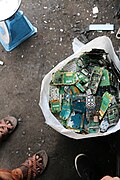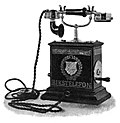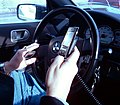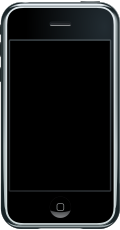Portal:Telephones

A telephone, colloquially referred to as a phone, is a telecommunications device that enables two or more users to conduct a conversation when they are too far apart to be easily heard directly. A telephone converts sound, typically and most efficiently the human voice, into electronic signals that are transmitted via cables and other communication channels to another telephone which reproduces the sound to the receiving user. The term is derived from Ancient Greek: τῆλε, romanized: tēle, lit. 'far' and φωνή (phōnē, voice), together meaning distant voice.
In 1876, Alexander Graham Bell was the first to be granted a United States patent for a device that produced clearly intelligible replication of the human voice at a second device. This instrument was further developed by many others, and became rapidly indispensable in business, government, and in households. (Full article...)

A mobile phone or cell phone is a portable telephone that allows users to make and receive calls over a radio frequency link while moving within a designated telephone service area, unlike fixed-location phones (landline phones). This radio frequency link connects to the switching systems of a mobile phone operator, providing access to the public switched telephone network (PSTN). Modern mobile telephony relies on a cellular network architecture, which is why mobile phones are often referred to as 'cell phones' in North America. (Full article...)
A smartphone is a mobile phone with advanced computing capabilities. It typically has a touchscreen interface, allowing users to access a wide range of applications and services, such as web browsing, email, and social media, as well as multimedia playback and streaming. Smartphones have built-in cameras, GPS navigation, and support for various communication methods, including voice calls, text messaging, and internet-based messaging apps. Smartphones are distinguished from older-design feature phones by their more advanced hardware capabilities and extensive mobile operating systems, access to the internet, business applications, mobile payments, and multimedia functionality, including music, video, gaming, radio, and television. (Full article...)
Selected article -

Bell Canada (commonly referred to as Bell) is a Canadian telecommunications company headquartered at 1 Carrefour Alexander-Graham-Bell in the borough of Verdun, Quebec, in Canada. It is an ILEC (incumbent local exchange carrier) in the provinces of Ontario and Quebec; as such, it was a founding member of the Stentor Alliance. It is also a CLEC (competitive local exchange carrier) for enterprise customers in the western provinces.
Its subsidiary Bell Aliant provides services in the Atlantic provinces. It provides mobile service through its Bell Mobility (including flanker brand Virgin Plus) subsidiary, and television through its Bell Satellite TV (direct broadcast satellite) and Bell Fibe TV (IPTV) subsidiaries.
Bell Canada's principal competitors are: Rogers Communications in Ontario and Western Canada, Telus Communications in Quebec and Western Canada, Quebecor (Videotron) in Quebec plus other Global Wireless Infrastructure Providers such as American Tower. The company serves over 13 million phone lines and is headquartered at the Campus Bell complex in the borough of Verdun in Montreal. (Full article...)
Types of phones -

A sound-powered telephone is a communication device that allows users to talk to each other with the use of a handset, similar to a conventional telephone, but without the use of external power. This technology has been used since at least 1944 for both routine and emergency communication on ships to allow communication between key locations on a vessel if power is unavailable. A sound-powered phone circuit can have two or more stations on the same circuit. The circuit is always live, thus a user begins speaking rather than dialing another station. Sound-powered telephones are not normally connected to a telephone exchange. (Full article...)
Selected audio -
Dual-tone multi-frequency (DTMF) signaling is a telecommunication signaling system using the voice-frequency band over telephone lines between telephone equipment and other communications devices and switching centers. DTMF was first developed in the Bell System in the United States, and became known under the trademark Touch-Tone for use in push-button telephones, starting in 1963. The DTMF frequencies are standardized in ITU-T Recommendation Q.23. The signaling system is also known as MF4 in the United Kingdom, as MFV in Germany, and Digitone in Canada. (Full article...)
List articles

- Comparison of smartphones
- List of best-selling mobile phones
- List of countries by number of broadband Internet subscriptions
- List of countries by number of telephone lines in use
- List of countries by smartphone penetration
- List of country calling codes
- List of iPhone models
- List of mobile network operators
- List of mobile phone brands by country
- List of mobile phone generations
- List of telecommunications companies
Related portals
General images -
Selected biography

Charles Bourseul (28 April 1829 – 23 November 1912) was a pioneer in development of the "make and break" telephone about 20 years before Bell made a practical telephone. (Full article...)
Selected images
Topics
Subcategories

More
 |
Here are some tasks awaiting attention:
|
Telephones in the news
No recent news
Associated Wikimedia
The following Wikimedia Foundation sister projects provide more on this subject:
-
Commons
Free media repository -
Wikibooks
Free textbooks and manuals -
Wikidata
Free knowledge base -
Wikinews
Free-content news -
Wikiquote
Collection of quotations -
Wikisource
Free-content library -
Wikiversity
Free learning tools -
Wiktionary
Dictionary and thesaurus















































































































